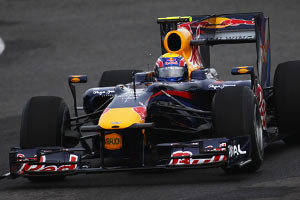raymondu999 wrote:I need to backtrack a bit now. I think Lewis meant the 2009 McLaren had half the downforce of the 2009 RB5.
Regarding the 3rd damper/spring, why that one in particular? Wouldn't it also be similarly affected with regards to downforce/rideheight? (Mods if this question is veering off please feel free to transport into another/new thread)
well we will go way off topic, but I will try to make it short & simple.
if we talk about suspension movement, we have some basic modes
roll (movement of the car body/sprung mass left to right around the roll axis)
pitch (movement of the car body/sprung mass fore and aft around the pitch axis)
heave(movement of the car body/sprung mass up and down, parallel to the ground)
wrap (opposing roll of front and rear axle)
single wheel event/input (only one wheel moves (up or down), small bump in the road etc)
and combinations of the modes e.g. roll+pitch (cornering and braking at the same time)
a "normal" car with 4 spring/dampers (one for each wheel) can only use this 4 dampers/springs to control all the modes. So if you need to support more downforce (aero load) you would need to stiffen these springs.
But this will affect all the other modes as well, and this is not allways good.
So if possible, you try to de-couple this modes as much as you can, so you can tune them seperate and indepentend of each other.
The most easy and simple example is the Antiroll bar (ARB) which is basicly a spring which only works in the roll/wrap mode, and a bit in the single wheel event mode (half the ARB rate), but did not do anything in pitch or heave events.
So if you stiffen the ARB´s of your car, the car will roll less, but still ride the same and react the same to heave and pitch events (e.g. under braking)
So you can tune the roll/wrap mode indepentend fom the pitch/heave mode
Now if you add a 3rd spring/damper like in a F1 car, you have a device, which works most when both wheels of one axle move in the same direction at the same time. This is the case in pitch and heave events.
In perfect roll mode (the damper/spring one one side compresses the other extends at the the same amount) this damper/spring don´t move at all.
You can have a car which is soft in roll but stiff in heave/pitch.
In the event of a single wheel movement, the 3rd damper/spring will move at half the amount of the single wheel damper/spring.
Aero load (downforce) is speed dependent and is a heave/pitch event.It moves/presses the body/sprung mass of the car towards the ground. If you have the same downforce front and rear, the body will move parallel closer to the ground.
If you have more on one axle the car will also pitch, changing it´s rake (ride heigth front to rear)
With the 3rd spring/damper you have control over this motion, without affecting the roll stiffness of the car, and you can control the pitch angle of the car as well, by choosing different stiffness front to rear.
At low speeds (corners, beginning of straight) the 3rd spring can be disengaged (gap to the bumpstop at the 3rd damper for example) and you can use the softer spring/dampers at each wheel for better traction/grip.
You see at the first photo of the Ferrari suspension the gap before the bellville washers get in contact (3rd spring)and the white plastic washers (packers).With this packers you can modify(take them off or put more) the point when the 3rd sping comes into play (at which ride height)
Therefore a 3rd spring gives you the option to control your aeroload/ride height at high speeds, without affecting and compromising the low speed grip and the roll stiffness of your car at the same time. (or less so)
maybe have a look at the youtube videos in this thread for a better understanding of the above.
viewtopic.php?f=6&t=8737&start=60
Sorry long post and way off topic, but I hope it makes a bit of sense, and answers your question.
If not, please feel free to PM me.









